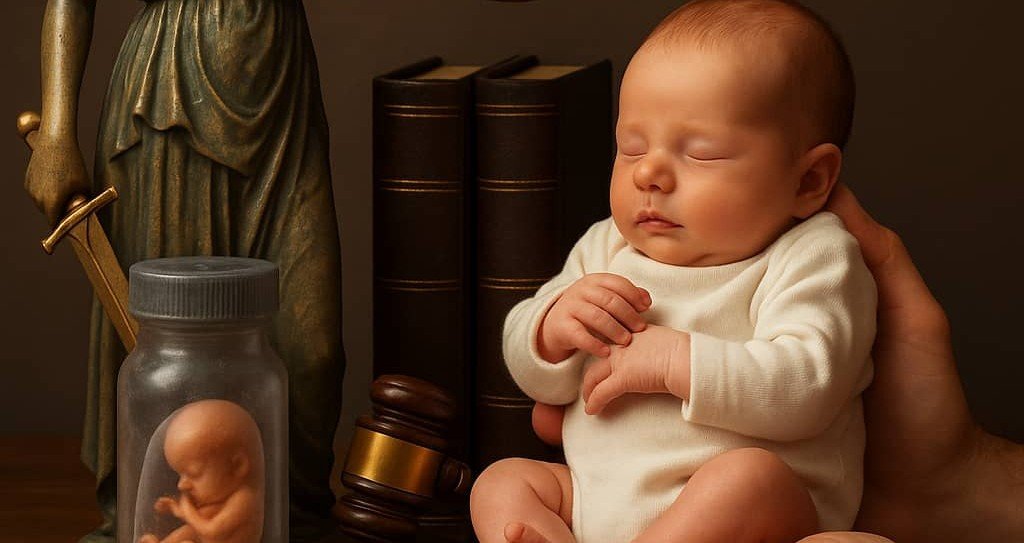By: Isaac Christopher Lubogo
The recent birth of Thaddeus Daniel Pierce, born from an embryo frozen since 1994, introduces not only medical marvel but a profound jurisprudential dilemma within the realm of family law. At a jurisprudential level, this groundbreaking event compels legal thinkers, policymakers, and courts alike to rethink the very nature, purpose, and principles of family law, particularly as it pertains to the concepts of parentage, inheritance rights, custody, and ethical governance of assisted reproductive technologies (ART).
1. The Conceptual Redefinition of Parentage and Family
Family law jurisprudence historically assumes biological parenthood occurs naturally and contemporaneously. Yet, the birth from a decades-frozen embryo forces reconsideration of traditional temporal concepts tied to parentage. Jurisprudentially, this challenges core assumptions:
Who constitutes a “parent“?
Traditionally, parentage was easily defined by biological immediacy or direct adoption. Embryo adoption complicates parentage, introducing the figure of the “genetic donor”—a person whose biological contribution predates by decades the child’s actual birth and family formation. Does the genetic donor retain any rights? How clearly must law demarcate genetic contribution from social and legal parentage?
Parentage across generational timelines:
Family law, historically synchronized with contemporaneous familial generations, must now confront scenarios where parents legally recognized at birth might not biologically align with the conventional generational order. Thaddeus’s embryo origin from 1994 means his biological siblings could already be adults or have families of their own. Thus, jurisprudence may grapple with intricate cross-generational claims in inheritance, custody, and guardianship rights.
As Justice Brennan famously emphasized in Moore v. City of East Cleveland (1977):
> “Ours is by no means a tradition limited to respect for the bonds uniting the members of the nuclear family.”
This birth compels jurisprudential adaptation beyond traditional familial structures, creating new familial relationships that span unprecedented temporal and generational boundaries.
2. Ethical and Legal Boundaries in Assisted Reproductive Technologies (ART)
The case of Thaddeus Daniel Pierce is a vivid reminder of the ethical and regulatory lacuna in ART. It underscores the necessity for clearer legal frameworks concerning:
Duration and Limitations of Embryo Storage:
Is there a morally or legally justifiable limit to the length of cryopreservation? Could indefinite preservation inadvertently cause harm through identity confusion or inheritance disputes across significantly diverging timelines?
Consent and Autonomy:
Does original consent (in this case, dating back to 1994) still retain legal force decades later? Must laws now stipulate conditions under which original consent must be periodically reaffirmed, amended, or explicitly renewed?
Ethical Guidelines for Embryo Donation:
Embryo donation differs fundamentally from traditional adoption, yet it also transcends traditional gamete donation. Laws must reflect nuanced ethical positions regarding donor anonymity, informed consent, and future disclosures to the child born decades later.
The landmark case of Davis v. Davis (Tenn. 1992) provides jurisprudential guidance, having grappled with embryo custody, stating:
> “Embryos occupy an interim category that entitles them to special respect because of their potential for human life.”
This “special respect” requires new jurisprudential interpretations, updated to embrace embryo lifespans spanning decades.
3. Jurisprudential Challenges in Succession and Inheritance Law
From a jurisprudential standpoint, this scenario introduces intricate complexities around inheritance rights:
Delayed Succession Claims:
With embryos stored for decades, succession claims could arise long after parents or biological siblings have died. Legislators and jurists must decide how long estates remain open, how rights accrue to a child born decades after the death of genetic parents, and what time limits are legally enforceable to maintain equitable estate administration.
Future-Proofing Inheritance Statutes:
Family jurisprudence must now consider explicitly accommodating ART-born children, including embryo-adopted children, within inheritance frameworks, ensuring equitable protections without prejudice or discrimination based on technological advances in reproduction.
Jurisprudential precedent from Woodward v. Commissioner of Social Security (Mass. 2002), which involved posthumously conceived children, will increasingly serve as jurisprudential signposts for cases like Thaddeus’s, emphasizing the necessity of intentional consent and timely succession claims.
4. Redefining “Best Interests of the Child” in Family Law Jurisprudence
The “best interests of the child” standard is fundamental in family law jurisprudence. With embryos stored for decades before implantation, jurisprudential questions arise:
Psychological and Emotional Welfare:
Courts may consider whether it serves a child’s psychological welfare to discover they originated from embryos older than their parents’ marriage, with biological siblings potentially decades older. Jurisprudence must proactively balance disclosure transparency against psychological risks.
Identity and Heritage Rights:
Embryos frozen over long periods implicate children’s right to know their biological heritage, familial history, and genetic identity. Family law must define the boundaries of these rights vis-à-vis the privacy and autonomy of genetic donors, and jurisprudence will be tasked with striking these balances.
In Troxel v. Granville (2000), the U.S. Supreme Court recognized the primacy of parents’ rights to make child-rearing decisions, yet these embryo scenarios might warrant reconsideration of what “parental decisions” truly encompass regarding identity disclosures.
5. Philosophical and Jurisprudential Reflections
At its deepest level, this unprecedented event compels philosophical jurisprudence to reconsider core principles of law and nature:
Time and Personhood:
This case challenges jurisprudential reflections on personhood and legal identity, stretching traditional family law conceptions to accommodate technology-driven temporal disjunctions between creation, gestation, and birth.
Jurisdictional and International Harmonization:
The international dimension of ART jurisprudence suggests the necessity for cross-border regulatory frameworks, jurisprudential standards, and ethical guidance, especially given the globalized and diverse approaches to embryo storage and adoption.
As John Stuart Mill aptly stated:
> “Law must be responsive to the needs of society and the evolution of its moral and ethical understanding.”
Towards Adaptive Family Law Jurisprudence
The birth of Thaddeus Daniel Pierce symbolizes a jurisprudential tipping point in family law. It requires judiciaries, legislators, and legal scholars to recalibrate traditional frameworks to reconcile longstanding principles of family law with the revolutionary scientific reality of ART. Family jurisprudence is thus compelled into an era marked by adaptability, clarity in consent, regulation of technology, recognition of temporal complexities, and unrelenting dedication to children’s welfare.
Thaddeus’s birth is more than a medical triumph; it is a jurisprudential landmark—calling for a progressive and humane family law framework that embodies clarity, ethical accountability, temporal sensitivity, and unwavering respect for the evolving nature of family itself.
Jurisprudential Implications of the Oldest Frozen Embryo Birth under Ugandan Family Law
The birth of Thaddeus Daniel Pierce, from an embryo frozen since 1994, is not merely a global curiosity—it carries profound implications for family law jurisprudence in Uganda, a jurisdiction whose legal regime is largely silent or underdeveloped on assisted reproductive technologies (ART). Such unprecedented medical advancements pose novel jurisprudential questions, particularly relating to parentage, succession, and ethical governance.
1. Parentage and Definition of ‘Family’ in Uganda
Under Uganda’s legal framework, notably the Children Act (Cap 59), the notion of parentage and custody has traditionally been predicated on biological and immediate relational terms. However, jurisprudentially, the concept of “frozen embryos” challenges such existing definitions.
Legal Gap and the Need for Reform
Currently, Uganda’s family law regime does not specifically contemplate scenarios of embryo adoption or surrogacy, thus:
The traditional definition of a “parent,” as envisaged in Sections 4-6 of the Children Act, must be jurisprudentially expanded to clarify parental rights in embryo adoption cases.
The courts might adopt an interpretation guided by the child’s welfare principle (Article 34 of Uganda’s 1995 Constitution), prioritizing the child’s best interests over strict biological linkages. This was notably emphasized by the Constitutional Court in the seminal case of Law Advocacy for Women in Uganda v Attorney General (Const. Petition No. 13/2005), underscoring the need to adapt family law to evolving societal conditions.
2. Ethical and Regulatory Challenges under Ugandan Law
Uganda lacks robust regulatory provisions on ART, embryo donation, and surrogacy. Currently, Ugandan jurisprudence has not significantly addressed this gap, potentially leaving families, medical professionals, and courts in ethical and legal uncertainty.
Recommended Legal Jurisprudential Response
Jurisprudentially, Uganda needs clear statutory guidelines regulating embryo storage duration, informed consent, and ART processes.
Comparative jurisprudence could guide Uganda, borrowing principles from international jurisdictions like South Africa (Children’s Act, 2005) and Kenya (Assisted Reproductive Technology Bill, 2019), thus filling the lacuna through persuasive jurisprudential reasoning.
3. Succession and Inheritance Implications
In Uganda, succession and inheritance laws (Succession Act, Cap 162) rely on clearly defined familial and generational lines. A child born decades after embryo creation poses significant jurisprudential complexities:
Delayed inheritance claims could arise if biological parents pass away before embryo implantation and birth. Would Ugandan courts recognize inheritance claims decades after parental death?
Uganda’s jurisprudence would require adapting traditional succession doctrines, possibly through innovative interpretations, ensuring equitable inheritance rights, consistent with Article 21 (equality) and Article 26 (right to property) of the Constitution.
The Supreme Court decision in Administrator General v George Mwesigwa Sharp (Civil Appeal No. 6 of 2000), which emphasized clarity in inheritance rights, provides a useful foundation for jurisprudential expansion accommodating delayed ART-related claims.
4. Child Welfare and the Best Interest Principle
The cornerstone of Ugandan child law jurisprudence is the “best interests of the child” doctrine (Article 34 Constitution, Section 3 Children Act). ART births from older embryos raise questions:
Courts must navigate how discovering decades-old embryo origins impacts a child’s emotional and psychological welfare.
In Ugandan jurisprudence, disclosure rights regarding biological heritage have precedent: the High Court’s decision in Edith Nakalema v Attorney General (Family Cause No. 127/2018) prioritized identity rights and welfare over parental confidentiality. Similar principles would guide cases involving embryo-origin children.
5. Jurisprudential and Philosophical Adaptation in Ugandan Context
The evolution of jurisprudence around ART births demands philosophical reflection from Ugandan judges and legal scholars:
Uganda’s family jurisprudence must embrace philosophical jurisprudence, recognizing “personhood” beyond immediate biological conception.
Jurisprudentially, Ugandan courts might invoke progressive international doctrines like the “right to identity,” recognized in Article 8, UN Convention on the Rights of the Child, guiding jurisprudential evolution toward greater inclusion and flexibility.
6. Potential Jurisprudential Roadmap for Uganda
Given the current jurisprudential vacuum, Uganda must:
Enact comprehensive ART legislation clarifying parental rights, embryo storage, consent mechanisms, and succession rights.
Strengthen judicial precedents through case law, clarifying inheritance rights of children born via ART.
Integrate international best practices into domestic jurisprudence, particularly leveraging human rights principles applicable to ART situations.
Ugandan jurisprudence must recognize and explicitly accommodate such technological developments, ensuring justice remains responsive to evolving societal, medical, and ethical realities.
Conclusion
The birth from the oldest frozen embryo compels Ugandan family law jurisprudence into new territory, necessitating immediate legal reform, jurisprudential innovation, and philosophical openness. Guided by core constitutional values, comparative jurisprudence, and international human rights standards, Uganda’s family law must evolve proactively to embrace these profound medical and ethical advancements, ensuring that law continues to protect and reflect society’s evolving understandings of family, parentage, and inheritance.
In doing so, Uganda will strengthen its family law jurisprudence, aligning it firmly with the constitutional mandate of fairness, equality, child welfare, and legal adaptability—hallmarks of a progressive legal system in the 21st century.








